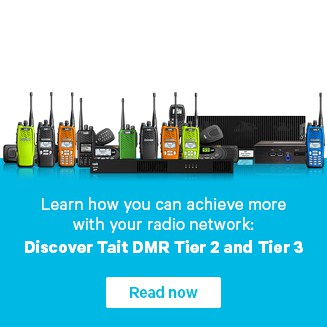Introduction to DMR
Channel Operation and Configuration
Physical and Logical Channels
This topic covers the two kinds of channels that are included in a DMR system.
DMR uses physical hardware channels, which is a receiver and a transmitter operating in a 12.5-kilohertz narrow bandwidth. You can see in the diagram below, a base station split into a receiver and a transmitter. Typically, a transmitter will transmit and the portables will receive. The portable, when it transmits back, will be picked up at the receiver.
In addition to this, in a DMR system also uses logical channels. On the transmitter, there are two time slots which are part of the 12.5-kilohertz bandwidth. Between the portable and the transmitter at the base station, there is a two-way path, a logical path using time slots. When the portable transmits back, it transmits on a discrete time slot as part of that channel. That is called a logical channel. The physical channel is the hardware. The logical channel are the time slots.
So, in a DMR system, the transmitter at the base station transmits on a certain frequency. We’ll call that frequency one. The transmitter is frequency one, which is the same frequency for receive on a portable or a mobile.
At the base station, the receiver will work on a second frequency, which we’ll call frequency two, and that is the frequency transmitted from the mobile and the portables. In a DMR system, each physical channel is split into two logical channels using TDMA. So two time slots for transmit, two time slots for receive. Each logical channel on a DMR system is a communication path for voice or for data.
In DMR Tier Three, each channel can be categorized in two ways. Firstly as a control channel, or as a traffic channel, which is sometimes called a payload channel. This is where the payload is voice packets or data packets. So, in a DMR trunked network, each site has one control channel and several traffic channels. These are logical time slot channels. To make a call between sites, several traffic channels can be used on different sites. For multi-site group calls or inter-site individual calls, a traffic channel is used at each site involved in the call.
Channels can be set up with the following options;
- Allow control
- Allow traffic
- Or to inhibit if jammed.
Jammed meaning excess noise or interference on the channel. Typically at a site, only one channel is allowed to be the control channel. Other channels would be allowed to be traffic and they’d also have inhibit if jammed enabled.
 Radio Academy
Radio Academy





